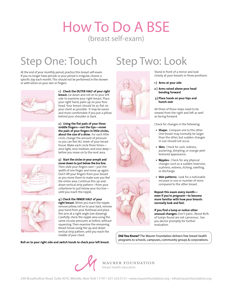Breast Health: Self-Exams and Screenings
Breast health is a critical aspect of overall well-being for women of all ages. Regular self-exams and screenings play a pivotal role in early detection of potential breast abnormalities, including breast cancer. In this article, we will explore the importance of self-exams and screenings in maintaining breast health and how they can be incorporated into your routine.
Self-Exams
Performing regular self-exams is a simple yet effective way to stay proactive about your breast health. Experts recommend conducting self-exams once a month, ideally a few days after your menstrual cycle when breasts are less tender and lumpy. The following steps can guide you through a proper self-exam:
Begin by looking at your breasts in the mirror, checking for any visible signs of abnormalities such as changes in size, shape, or skin texture.
Raise your arms and visually inspect your breasts again, paying attention to any asymmetry or visible changes.
While standing or sitting, use your fingertips to gently feel your breasts in a circular motion, starting from the outer edges and moving towards the center. Remember to cover the entire breast area, including the armpit and collarbone region.
Apply different levels of pressure (light, medium, and firm) to ensure all breast tissues are properly examined. Focus on detecting any lumps, thickening, or areas of discomfort.
Lastly, examine your nipples for any signs of discharge, scaliness, or redness.
Screenings
In addition to regular self-exams, medical screenings are crucial in detecting breast abnormalities. Mammograms and clinical breast exams (CBE) performed by healthcare professionals can detect potential issues that may not be noticeable during self-exams. Here are the key screenings to consider:
Mammograms
Mammograms are X-ray examinations of the breast that can identify abnormalities at an early stage, including tumors or microcalcifications. It is recommended that women aged 40 and above undergo mammograms annually or as advised by their healthcare provider. However, certain factors such as family history or genetic predisposition may warrant starting mammograms earlier or increasing the frequency.
Clinical Breast Exams (CBE)
A clinical breast exam involves a physical examination performed by a healthcare professional. They will carefully feel your breasts, looking for any lumps or irregularities. CBEs are typically performed in conjunction with mammograms, especially for women aged 40 or older. Younger women may opt for CBEs in their regular check-ups to ensure comprehensive breast health.
When to Seek Medical Attention
While self-exams and screenings are essential in maintaining breast health, it is equally crucial to know when to seek immediate medical attention. If you observe any of the following signs, consulting a healthcare professional is highly recommended:
A new lump or thickening in the breast or underarm area.
Nipple discharge, especially if it is bloody, spontaneous, or occurs only in one breast.
Swelling, redness, or warmth of the breast.
Changes in breast size or shape, including dimpled, puckered, or scaly skin.
Unexplained breast pain or persistent breast discomfort.
Conclusion
Prioritizing breast health is essential for overall well-being. Regular self-exams and screenings are crucial tools in early detection and prevention of breast abnormalities. By being proactive and attentive to changes in your breast health, you can take control of your well-being and potentially safeguard yourself against serious conditions such as breast cancer.


